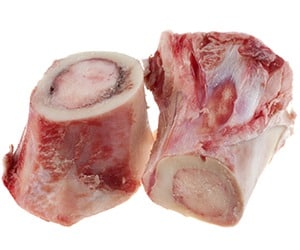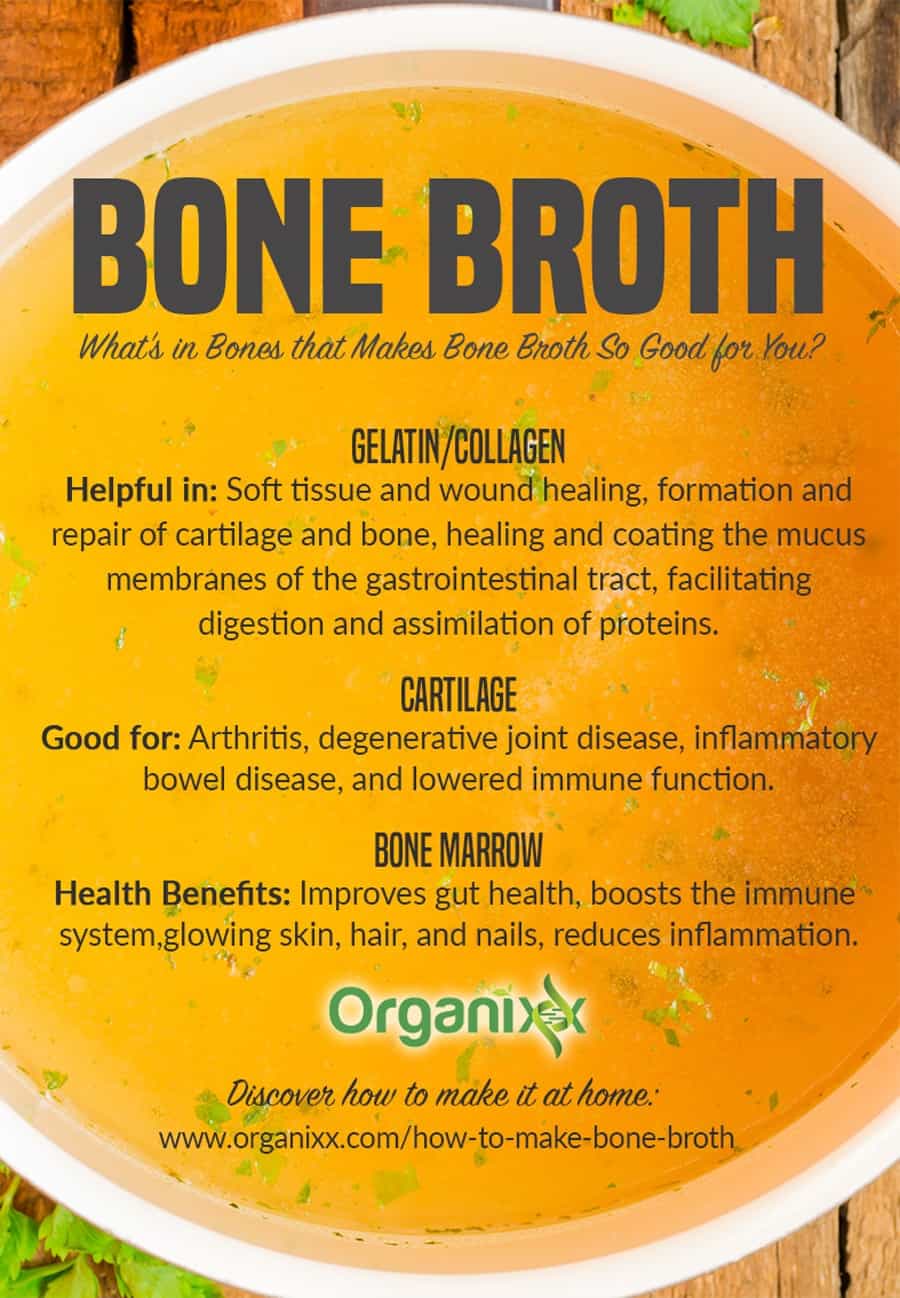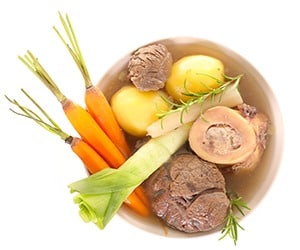How to Make Healing Bone Broth at Home
In a hurry? Click here to read the Article Summary...
The health benefits of broth made with bones have been researched and documented for hundreds of years. Around 1150, Benedictine Abbess and scholar Hildegarde von Bingen recommended in her Physica (medical text) that “frequent and adequate” portions of broth made with calves’ feet was good for relieving joint pain.
The Abbess was clearly on to something by recognizing the curative nature of bone broth. As it turns out, this ancient healing elixir has a number of other impressive health benefits that come from simmering animal bones for long periods of time. Read on for more about the health benefits of bone broth and tips on how to make bone broth at home.
What’s in Bones That Makes Bone Broth So Good for You?
When making (and consuming) bone broth, you benefit from 3 components of bones:
- gelatin (collagen)
- cartilage
- bone marrow
Gelatin/Collagen
When bone broth cools down it often congeals due to the presence of gelatin. Achieving this gelatinous state is highly prized by bone broth aficionados as it means the broth contains a significant amount of collagen. (Gelatin is essentially the same thing as collagen. When it’s in the body it’s known as collagen, and when it’s extracted to be used as food it is known as gelatin.)
While gelatin is not a complete protein and cannot replace protein in the diet, it has been used historically as a protein stretcher. It contains the amino acids proline and glycine, both of which are two important amino acids that aren’t abundant in animal meats.
A Brief History of Gelatin
The first large scale production of gelatin became possible in the late 1600s with the invention of the “digester” by Papin in 1682. This apparatus was a type of pressure cooker used for cooking bones or meat with steam.
Just over 100 years later, Europe was embroiled in the Napoleonic wars and the French turned to gelatin as a way to stretch meager meat portions and feed soldiers as well as the legions of starving homeless living on the streets of Paris and other cities.
Commissions appointed at that time by the Institute of France and the Faculty of Medicine in Paris to study the use of gelatin stated in their report that…
“Gelatin … confines a large quantity of nourishing material in a very small volume; it could be used on shipboard for making soup for the sailors on voyages to foreign ports, for soldiers in besieged cities, and even in the camps and barracks.”
More recent studies of gelatin have shown that it increases the digestion and utilization of other proteins such as meats, beans, milk, and milk products.
Collagen is helpful in:
- Soft tissue and wound healing
- Formation and repair of cartilage and bone
- Healing and coating the mucus membranes of the gastrointestinal tract
- Facilitating digestion and assimilation of proteins
Cartilage
Cartilage is primarily made from collagen and elastin proteins, but also contains glycosaminoglycans (GAGs), chondroitin sulfate, keratin sulfate, and hyaluronic acid. You might recognize chondroitin sulfate as a commonly used supplement for supporting joint health and mobility. It has also been shown to help improve inflammatory conditions of the gastrointestinal tract.
Using cartilage-rich beef knuckles, chicken feet, trachea, and ribs in bone broth is a cost-effective and easily absorbable alternative to pricey supplements.
Cartilage is considered beneficial in supporting inflammatory conditions such as:
- arthritis
- degenerative joint disease
- inflammatory bowel disease, and
- lowered immune function
Bone Marrow
 Bones contain one of two types of marrow: yellow or red. Yellow marrow produces fat, cartilage, and bone and is found in the central portion of long bones.
Bones contain one of two types of marrow: yellow or red. Yellow marrow produces fat, cartilage, and bone and is found in the central portion of long bones.
Red marrow is where red blood cells, white blood cells, and platelets are formed. It is found in flat bones such as the hip bone, sternum, skull, ribs, vertebrae, scapula, and the end of long bones.
Red marrow is especially valued as it is where blood stem cells are formed. As such, it is an excellent source of nutritional and immune support.
For example, a chicken carcass makes an excellent bone broth as it has a high concentration of red marrow bones.
Health Benefits From Eating Bone Marrow
- Improves gut health – bone marrow is easily digested and contains nutrients that help heal the digestive tract and improve nutrient absorption.
- Boosts the immune system – the strength of your immune system is linked to your gut health. Consuming bone marrow regularly helps strengthen the gut which will help to ward off illness and chronic disease.
- Glowing skin, hair, and nails – good health is usually reflected in strong, shiny hair and nails and in smooth, clear skin. Bone marrow contains gelatin (collagen) which is transferred into bone broth and into you when you consume it. Gelatin grows and strengthens hair and nails, and helps to smooth lines, wrinkles, and even cellulite.
- Reduces inflammation – One of the best ways to decrease inflammation is through a good diet. Eliminate or restrict inflammatory foods (i.e. vegetable oils, sugar, gluten, and GMO foods), and add the benefits of amino acids found in bone marrow: arginine, proline, and glycine.
Choosing Bones for Bone Broth
You can purchase raw bones from a butcher or use bones leftover from cooking. For example, if you make a bone-in roast, save the bone(s) to make bone broth. If you cook a chicken, save the carcass.
If you don’t want want to make broth right away (or you don’t have enough bones), simply place the bones in a sealed freezer bag and store in the freezer until you’re ready. When it’s time to make broth, you don’t even need to defrost the bones first.
When purchasing bones for making homemade bone broth, aim to get a variety of bone types which will ensure you’re getting marrow, cartilage, and gelatin in your broth.
If you’re adventurous, you can try adding a couple of (well cleaned) chicken feet along with the bones which are an excellent source of collagen. For making beef or lamb bone broth, be sure to ask your butcher for both a joint bone and marrow bones.
Your #1 consideration when making bone broth is the QUALITY of the bones you use. Do your best to source the highest quality bones possible from pasture-raised/free-range animals that are grass fed and have not been subjected to antibiotics, growth hormones, and/or conventially grown feed which have been sprayed with glyphosate. (You can read more about the dangers of toxins in bone broth here.)

Step-by-Step Instructions on How to Make Bone Broth
 You may have read about the need to roast bones first before making bone broth. Some people prefer this method as they find it adds extra flavor to the finished broth. Roasting is totally a taste preference and is not required. In any case, it is only for beef, lamb, or wild game bones – it is not a necessary step for bone broth made with poultry or fish.
You may have read about the need to roast bones first before making bone broth. Some people prefer this method as they find it adds extra flavor to the finished broth. Roasting is totally a taste preference and is not required. In any case, it is only for beef, lamb, or wild game bones – it is not a necessary step for bone broth made with poultry or fish.
If you’re new to making bone broth it may be easier to skip the roasting step until you become more practiced with the process. If you do wish to roast the bones first, all you need to do is place the bones on a baking pan and roast uncovered in a 350F oven for 20-30 minutes.
Once you’ve gathered your bones (either raw or roasted), you’re ready to proceed with the steps below.
Step #1:
Place bones (fresh, frozen, or roasted) into a large stock pot or crock pot and cover with cold filtered water. Make sure all the bones are covered, but still leave plenty of room for water to boil. Add coarsely chopped onion, carrots, and celery stalks to the pot.
Step #2:
Add two tablespoons of an acidic substance (eg. apple cider vinegar, wine, or lemon juice) to the water prior to cooking. The acid will help draw out important nutrients from the bones.
Step #3:
Heat slowly, gradually bringing to a boil and then reduce heat to a simmer. Skim off any scum that floats to the top.
Step #4:
Cook long and slow. Cook chicken bones for at least 6 to 24 hours (up to 48 hours). Beef bones can cook for 12 to 48 hours (and even up to 72 hours). A long and slow cooking time is necessary in order to fully extract the nutrients in and around the bones. You may need to add additional hot water as the broth simmers to keep the bones covered.
Step #5:
Add additional vegetables and/or seasonings such as sea salt, pepper, herbs and peeled garlic cloves to the pot 1-2 hours before finishing. (Optional) Add a bunch of fresh parsley 10-15 minutes before removing from heat.
Step #6:
Once broth is ready, remove from heat and allow broth to cool enough so you can handle the pot. Remove the solids, strain through a fine mesh strainer, and reserve the broth. If there was meat on the bones, you can pick this out to use in a soup if desired.
Step #7:
Consume broth within 5-7 days or freeze for later use. Bone broth can be safely frozen for several months.
Bone Broth Tips
- Using a crock pot that can be continually re-set for several hours at a time is likely a safer and easier option for most people. If you are using the stovetop method, be sure to keep an eye on your broth and follow good stove safety practices. An Instant Pot (pressure cooker) is another option. You can learn the pros & cons of different bone broth cooking methods here.
- After the broth cools, a protective layer of fat will harden on top. Only discard this layer when you are about to eat the broth. Alternatively, you may choose to consume it along with the broth. If your bones are from quality pastured animals, this is a healthy, nutrient-dense source of fat. Another option is to save this fat in a jar in the fridge and use it as a cooking oil when making other dishes.
- If your broth becomes thick and jelly-like – congratulations! That means it contains a significant amount of gelatin (collagen). When you heat up your broth, it will turn back into liquid form.
- To warm up your broth, scoop some into a saucepan and gently heat your broth on the stove, not in a microwave oven. This will retain the maximum possible nutrients. Season with salt & pepper and/or add other health-promoting spices such as turmeric, ginger, etc.
- There are many ways to use bone broth. It is delicious to drink by itself, or use it as a soup base, in sauces, and to replace the water when cooking rice, quinoa, or other grains.
Organixx Clean Sourced Collagens blend contains five types of collagen from four sources. What’s more, it’s combined with targeted nutrients such as zinc, vitamin C, and vitamin B6 which specifically enhance the bioavailability and potency of collagen. Clean Sourced Collagens is formulated from the ground up to enhance and support your body’s natural ability to heal and rebuild itself from the INSIDE out.

 Sources:
Sources:
Article Summary
Benefits of bone broth come from collagen, cartilage, and bone marrow.
Collagen is useful for healing as well as digestion.
Cartilage is considered beneficial in supporting inflammatory conditions.
Benefits of bone marrow include gut health, immune support, and anti-inflammatory properties.
It is important to select a variety of organic bones to reap maximum benefits.




I have been doing this for some time now, sadly it did not help repair my cartilage in hips and I had to have an op but it could have helped delay the op by a few years.However it is great for keeping the skin young and supple and definitely well worth doing. I add it to soups and sauces, it doesn't taste bad on its own either. Definitely will continue with this.
Can the marrow still be eaten after making the broth?
Can I add things like potato, carrots, spinach and kale to my broth?
Yes definitely, makes a great vegetable soup.
Where on earth can we buy SAFE, hormone Free Bones?
If you’re lucky like us NorCal folks, you can find local farm collectives with the best free range animals living healthy lives until they have that one bad day. Then the butchers come in and we celebrate their lives with a feast!
co-ops and local animal farmers at your local Farmers Market
Longs meat market
What about using a pressure cooker to make bone broth?
I've bought thrm at Whole Foods
Definitely buy them at Whole Foods if they have them on the day you ask for them. But don't bother leaving a "will call" order for the next shipment. You will never get a phone call. Now that Whole Foods has been sold to Amazon owner, Jeff Bezos, it is anyone's guess what the new pricing structure will be and what quality all of the merchandise will be.
What is the ratio for lbs of bones to volume of water. Want to maximize my yield.
Covering the bones with liquid is prob the best ratio. That's what's taught in cooking schools. May need to add more liquid as the stock summers and reduces
I bought an 18 quart Slow roaster with lift out container. Roast First for much better flavor. Put into roaster. I buy 15 or so pounds of marrow bones from local pasture raised cattle. Best Gel is to BARELY COVER with water all the bones. Too much water...less gel. More joints, neck etc more gel. I let mine go till the bones are clear through. Pick one bone out with pro silicone grips. Is it still pretty solid inside? Keep on slow roasting. I've let mine go for 3-4 FULL DAYS...all night as well. BEAUTY of the electric slow roaster. WASTE OF TIME to do such a small batch. I wait toward the END hours to add two full heads of garlic and lots of onions....I put a cheese cloth and CLAMP IT to the top of a 16 quart stock pot and wait a couple hours for a slight cooling down.....with PRECISION, I quickly pour through the cheese cloth. I fill quart containers (not glass) with the MEDICINE/FOOD then let it cool for a couple hours then into the FREEZER. I keep one quart in the frig for adding to whatever. FABULOUS.
What du you du with the stuff in your cheese cloth there is still all that marrow you need to put in your broth
Thanks so much for these precise instructions! I really struggle with bone broth. It's always an ordeal. I hardly ever get it to gel. :-/ How come your quart containers are not glass?
Thank you for this recipe. I will definitely try it.
I eat a plant based diet. How can I get enough protein? I do not eat animals or dairy products.
Quinoa is a great source of protein
Hemp seed! "Whole, hulled hemp seeds are about 33 percent protein and provide 11 g of protein per 3 tbsp. serving, or 30 g. The protein content of hemp seeds is higher than that of other nutritious seeds. Chia seeds contain about 4 g of protein per 30 g. Sesame seeds offer 5 g and pumpkin seeds offer 10 g." This info comes from Livestrong.com but google "hemp seed" and you'll be overwhelmed with positive facts! Good luck! PS: the ones without hull are more expensive and less nutritious, but they have the advantage of not getting stuck between your teeth. I grind organic whole seeds in a coffee-grinder until they are powder and then use them in smoothies.
Thanks for the great info.
Spirulina contains alot of protein. Beans and rice contain building blocks of protein so eating them at the same time is a centuries old practice. Do you eat eggs? Brewer's yeast also contains alot of amino acids.
How many bones per regular sized crock pot? They are rather expensive at Whole Foods. And can you mix up the bones you save? Can they be already cooked?